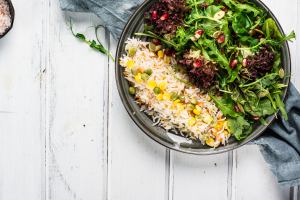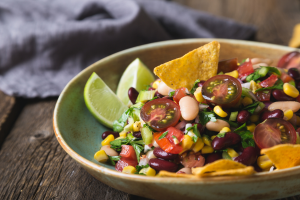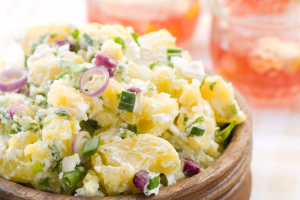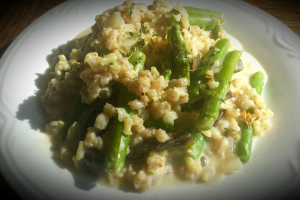Each color comes with a set of its own nutritional profiles; these attribute to an all-around healthier lifestyle. Just like with processed foods – everything should be eating in moderation, and even the healthiest of foods is no exception. We need variety in our life to be reaping the benefits in the entire spectrum. Here Amanda lays down the nutritional benefits for each color and some fun and delicious ways you can enjoy them with a few special Rebel Recipe recipes to really fuel your appetite.

Red Food – Heart Healthy
Our heart is so important, for emotional and mental health, but also for our physical health. Foods like tomatoes, apples and red onions are well known for their heart health properties. So, ‘an apple a day’ really can keep the doctor away! Braeburn apples are top of the list; are not only a healthier sweet treat but they can pack a dose of energy when that 3 pm slump hits.
A heart-healthy Bolognese packed with tomatoes and red onions is also a fantastic way to up your reds; a fun way to get kids even more excited is to use that Bolognese on top of a pizza base! Delicious and family-friendly.
Orange & Yellow Foods – Eye See You
If you look right in the center of your retina you will see that there is a yellow spot filled with orange pigments. These pigments are called carotenes, which help to protect our vision. And what does carotene sound like? Yep, you got it – CARROTS. Carrots, sweet potatoes and mango are extremely rich sources of carotenoids.
In fact, the carotenes in mangos are twenty times more absorbable in the body than those of carrots, so don’t just limit your choice of orange foods to just carrots. Get a little more tropical and experiment with new flavors and textures. Think papaya and Sweet Melons and of course mangos
Fun fact: peeling carrots can reduce their health properties by more than half. Simply wash and eat..
Want to really boost the rainbow and your carotene? Try roasting your carrots for a healthy boost of carotene
Green Foods – Brilliant Bones
When we think of foods to build strong bones and teeth, it’s usually dairy products that pop to mind. But guess what – green foods are actually better for your bones than milk!
Cabbage, kale, and broccoli are some of the top products that help boost your bones. Look for lots of different ways to add these veggies into your diet by roasting them and serving with a bright chimichurri sauce for example, or check out a recipe for bubble and squeak.
Did you know: It takes up to ten times trying a new food for your taste buds to become acquainted with the flavor? So, set yourself a goal and choose a portion of food to try 10x and see what happens. Remember, the overboiled Brussel sprouts (ughhhhh) of childhood can be replaced by an awesome great shredded, oven-roasted sheet pan dish that could include but not limited to at least one veggie from each of the colors of the rainbow.
I love a dish that includes carrots, baby tomatoes, cauliflower, broccoli, peppers, diced sweet potatoes, mushrooms, corn, and even purple baby potatoes all roasted in the oven at a fair heat and served with a sauce of choice!.
Blue and Purple Foods – Brain Fuel
Not only are blue and purple-colored foods great for our mental health, but foods like blueberries, blackberries, blackcurrants, and grapes can also give you a brain boost.
One of the quirky things about these berries is that they are actually able to find their way into the areas of our brain that are essential for intelligence; they are also good for slowing the rate of mental decline.
With Summer here, platters of chopped raw veggies with a dip or two/ hummus is a great way of covering the whole range of veggies colors.
Reprinted from Rebel Recipes blog.
Tips to incorporate more veggies. From Dr.C.
Buy a rainbow selection of veggies ( a lot of veggies like carrots and celery can be precut and stored in baggies/containers….once a week prep time saves lots of frustration) Make platters with a variety of veg and cheese chunks and a dip in place of a salad….
I like to place a variety of bowls with things like veggies, spring onions, olives, shredded lettuce, and microgreens out on a counter, along with diced feta and cheddar cheese of choice and perhaps 2 or 3 dressings (my new fave is Panera’s Fuji apple…OOOH) and let everybody make their own selection. Toasted nuts such as pecans, walnuts, pumpkin seeds, and croutons (homemade is best) finish off the presentation.
Everything can basically be pre-prepped and stored in containers for easy grabbing and in summer supper is on the table double-quick time
With mac and cheese dishes, I have been known to roast/steam broccoli, mushrooms, onions, and shredded spinach and stir that into the mix. If you have fussy eaters make side dishes of the veggies and offer them as add-ons to suit.
One-pot casserole dishes are also a great place to hide veggies….grated zucchini, shredded spinach, steamed and mashed cauliflower are just some ingredients that can hide in a dish
GOLDEN RULE: NEVER TELL ANYONE WHAT YOU ARE DOING IF YOU HAVE PICKY EATERS!!!










